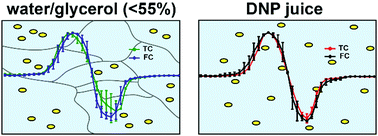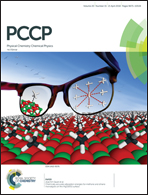Effect of water/glycerol polymorphism on dynamic nuclear polarization†
Abstract
A paramount feature of robust experimental methods is acquiring consistent data. However, in dynamic nuclear polarization (DNP), it has been observed that the DNP-induced NMR signal enhancement of nominally the same sample can vary between different experimental sessions. We investigated the impact of various freezing conditions on the DNP results for a standard sample, a 50/40/10 by volume d8-glycerol/D2O/H2O solution of 40 mM 4-amino TEMPO, and found that annealing the samples 10 K above the glass transition temperature (Tg) causes significant changes to the DNP profiles and enhancements compared to that in rapidly frozen samples. When varying the glycerol composition to yield a solution of 60/30/10 d8-glycerol/D2O/H2O, the DNP performance became markedly more consistent, even for samples prepared under vastly different sample freezing methods, in stark contrast with that of the 50/40/10 solution. The EPR lineshapes, Tm, and glass transition temperature, Tg, were measured under the same sample and experimental conditions as used for the DNP experiments to support the conclusion that different freezing methods change the distribution of 4-amino TEMPO radials in the 50/40/10 solution due to the formation of different polymorphs of the glass, which is mitigated in the 60/30/10 solution and is consistent with the water/glycerol vitrification literature.



 Please wait while we load your content...
Please wait while we load your content...
